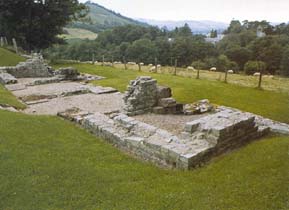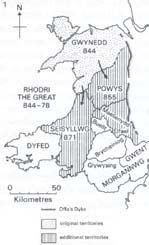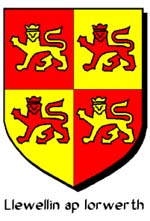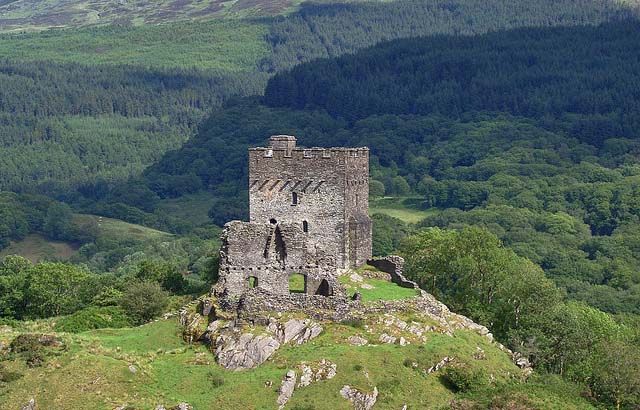Gwynedd and Wales
 This page was set up by Robert Sewell in September, 2001 to show the descent
of the ancient Kings of Gwynedd and Wales. Robert Sewell graduated
from McMaster University (Hamilton, Ontario, Canada) in 1967 with a B.Sc.
degree in chemistry. After a year of studies at the University of
Toronto's College of Education, he taught high school science in Collingwood,
Ontario for a year and then taught chemistry, physics and general science
in Hamilton, Ontario for twenty-nine years. Robert Sewell retired
from teaching in June 1998.
This page was set up by Robert Sewell in September, 2001 to show the descent
of the ancient Kings of Gwynedd and Wales. Robert Sewell graduated
from McMaster University (Hamilton, Ontario, Canada) in 1967 with a B.Sc.
degree in chemistry. After a year of studies at the University of
Toronto's College of Education, he taught high school science in Collingwood,
Ontario for a year and then taught chemistry, physics and general science
in Hamilton, Ontario for twenty-nine years. Robert Sewell retired
from teaching in June 1998.
Click
to Contact Robert Sewell
Please visit the Sewell
Genealogy Site Map for other pages in this series.
The information
presented, along with the various spellings of our name, here has
been taken from the following sources:
-
Sewell Vincent Sample (1928 – 2005): Letters
(perhaps
based on John Edward Lloyd: A History of Wales: From the Earliest Times to the Edwardian Conquest, Longmans, Green & Co.,1911.)
-
The Anglo Saxon Chronicle, Everyman Press,
London, 1912 (Translation by Rev. James Ingram, London, 1823)
-
Richard Thomson: An Historical Essay on the Magna
Charta of King John, London, 1829
- Sir John Edward Lloyd: A History of Wales: From the Earliest Times to the Edwardian Conquest, Longmans, Green & Co.,1911.
-
Sir James Balfour Paul: The Scots Peerage,
1904 - 1914, 9 volumes
-
The Book of History (18 Volumes), London, 1914
-
David C. Douglas: William the Conqueror,
Berkeley, California, 1964
-
Samuel Eliot Morison: The European Discovery of America,
New York, 1971
-
Wales Tourist Board: Wales Castles & Historic
Places, Cardiff, 1990
-
Berhard Grun, The Timetables of History, New
York, 1991
-
John Davies: A History of Wales, London,
1993 (published in Welsh as Hames Cymru in 1990)
-
Norman F. Cantor (ed.) The Encyclopędia of the
Middle Ages, New York, 1999
-
Frederick L. Weis and Walter L. Sheppard: Ancestral
Roots, 7th Edition, Baltimore, 1999
-
Frederick L. Weis and Walter L. Sheppard: The
Magna Charta Sureties, 1215, Baltimore, 1999
-
G.E. Cokayne: The Complete Peerage, Sutton
Publishing, 2003
-
Douglas Richardson: Plantagenet Ancestry,
Baltimore, 2004
-
Gary Boyd Roberts: Royal Descents of 600 Immigrants,
Baltimore, 2004
-
Douglas Richardson: Magna Carta Ancestry, Baltimore,
2005
-
Michael Corbishley et. al: The History of Britain
and Ireland, Oxford University, 2006
-
World Book Millenium 2000 Deluxe Edition, ©
1999 World Book Inc., © IBM Corp.
-
Microsoft Encarta Encyclopędia 99, ©
1993-1998 Microsoft Corporation
-
Brian Tompsett, Royal Genealogical Data, http://www.hull.ac.uk/php/cssbct/genealogy/royal/
Medięval Wales
Medięval Wales consisted of a
host of petty kingdoms, each overseen by a King or Prince; many of whom
were really little more than tribal chieftains. The larger and more
influential of these kingdoms were Dyfed and Gwent in the south, Powys
in the midlands and Gwynedd in the north. Gwynedd proved to be the
most influential. For further details and maps, please click on Medięval
Wales.
As with most early medięval or
“dark age” genealogies, the line shown here must be viewed with suspicion.
All the names mentioned can be found in Nennius: Historia Brittonum
(History of the Britons) and/or Geoffrey of Monmouth: Historia Regum
Britanniae (History of the Kings of Britain); but these works also
show legendary figures such as King Arthur. The line from Generation Sixteen
(Cynan Tindaethwy ap Rhodri, King of Gwynedd, died 816) on can be considered
accurate. Everything from Generation Sixteen on is shown in Sir John Edward Lloyd: A History of Wales: From the Earliest Times to the Edwardian Conquest, Longmans, Green & Co.,1911; John Davies: A
History of Wales, London, 1993 and elsewhere; see References.
Generation One
Tegid, who was also
known
by the Latinised name of Tacitus. Recall that the Romans had been in
Britain for 300 years by this time. For more about the Romans, click on Know the Romans. Another good website, especially for young
people, is The Romans.
Tegid (or Tacitus) had a son:
|

Brecon Gaer Roman Fort, Powys |
Generation Two
Padarn Beisrudd, who
was
also known by the Latinised name of Paternus of the Red Robe. Very
probably the "Red Robe" marked Paternus (or Pararn) as a high Roman
Official. It is possible that he had
been invested with his cloak as part of the efforts of Magnus Maximux
to
secure the borders of Britannia before departing with his army.
Padarn
was stationed in the Clackmannanshire area of Scotland. This is on the
north side of the Firth of Forth between Stirling and Fife.
Flourished circa 383
Padarn Beisrudd had a son:
Genertion Three
Ędeyrn, who was also
known by the Latinised name of Ęternus, had a son:
Generation Four
Cunedda Wledig, King of Gwynedd
who came from Manaw Gododin on the Firth of Forth with his eight sons and
one grandson to drive the Irish out of Gwynedd circa 440.
Flourished circa 440
"Cunedda, it may safely be inferred form the names of his immediate ancestors, Ęternus, Paternus and Tacitus,
came from a family which, whatever its origin, had been for some time
Roman and not Celtic in its manner of life and traditions." (John Edward Lloyd: A History of Wales: From the Earliest Times to the Edwardian Conquest, Longmans, Green & Co.,1911, page 118.)
Cunedda Wledig married Gwawl, a daughter of Coel Hen,
who was also known by the Latinised name of Caelius Votepacus. He
was an ancient British King in the north of Britain when the Romans left
in 410. Coel Hen is "Old King Coel" of nursery rhyme fame. Click
Coel
Hen for more information.
Cunedda and Gwawl had a son:
Generation Five
Einion Yrth, King of Gwynedd
Flourished circa 470
Einion had a son:
Generation Six
Cadwallon ap Einion, King of Gwynedd,
who was also known as Cadwallon Lawhir (the Long Handed) because he had
unusually long arms. Cadwallon ruled around the same time as the legendary
King Arthur and his victory over the Saxons at Mons Badonicus.
Flourished circa 500
Cadwallon had a son:
Generation Seven
Maelgwn ap Cadwallon,
King of Gwynedd who was also known as Maelgwn
Gwynedd and Maelgwn Hir (the Tall) was the King of Gwynedd. Maelgwn
has been portrayed as a ruthless, wicked ruler of impressive sinfulness.
He was also a man of culture, and many poets and musicians attended his
court at Deganwyand. He entered a monastery, perhaps to in an attempt
to atone for previous sins.
Died in 547 or 549 at Rhes of the yellow plague which
had originated in Egypt.
Maelgwn had a son:
Generation Eight
Rhun ap Maelgwyn, King of Gwynedd,
also known as Rhun Hir, was King of Gwynedd.
Died in 586.
Rhun ap Maelgwyn had a son:
Generation Nine
Beli ap Rhun, King of Gwynedd
Died in 599
Beli ap Rhun had a son:
Generation Ten
 Iago
ap Beli, King of Gwynedd and reputed benefactor
of Bangor Cathedral which is shown in the photograph as it is to-day.
Iago
ap Beli, King of Gwynedd and reputed benefactor
of Bangor Cathedral which is shown in the photograph as it is to-day.
Died in 616
Iago ap Beli had a son:
Generation Eleven
Cadfan ap Iago, King of Gwynedd
Cadfan was reputed to have been a wise king.
Died circa 625
Cadfan ap Iago had a son:
Generation Twelve
Cadwallon ap Cadfan, King of Gwynedd. Cadwallon
killed Edwin of Northumbria at the battle of Meigen (Hatfield near Doncaster)
in 632. In 633, he killed Edwin’s successors, Osric of Deria and
Eanfrith of Bernicia. The Venerable Bede declared that it was Cadwallon’s
intention to exterminate the English race. However, Cadwallon himself
was killed in late 633 or 634 by Eanfrith’s brother Oswald. This
defeat denoted the extinction of the possiblility of restoring Brythonic
supremacy in Britain.
Cadwallon died in late 633 or 634, killed in battle.
Cadwallon married a sister of Penda, King of Mercia;
and they had a son:
Generation Thirteen
Cadwaladr Fendigaid (the Blessed) ap Cadwallon,
King of Gwynedd
Died in 664 of plague
Calwaladr was still a child at the time of his father’s
death in 633 or 634 and he was excluded from the throne of Gwynedd for
twenty years or so by Cadafael ap Cynfeddw who was not of royal blood.
Calwaladr eventually succeeded as King of Gwynedd circa 655; perhaps by
killing Cadafael ap Cynfeddw.
Cadwaladr Fendigaid (the Blessed) ap Cadwallon had a
son:
Generation Fourteen
Idwal Iwrch ap Cadwaladr, King of Gwynedd
Died in 712
Idwal Iwrch ap Cadwaladr had a son:
Generation Fifteen
Rhodri Molwynog, King of
Gwynedd
Died in 754
Rhodri Molwynog had the following sons:
-
Hywel ap Rhodri
-
Cynan Tindaethwy ap Rhodri
Generation Sixteen
Cynan Tindaethwy ap Rhodri, King of Gwynedd.
Died in 816
Cynan and his brother Hywel were somehow excluded from
the throne by a distant cousin Caradog ap Meirion from the time of their
father’s death in 754 until 798. Cynan shared the Kingdom of Gwynedd with
his brother Hywel ap Rhodri. Cynan died in 816; and Hywel ruled Gwynedd
until his death in 825. At this time, Hywel was succeeded by Cynan’s grandson
Merfyn Frych. (See Generation Eighteen)
Cynan Tindaethwy ap Rhodri had a daughter:
-
Esyllt (also Ethyllt and Ethil)
Generation Seventeen
Esyllt (also Ethyllt and Ethil), Daughter the King
of Gwynedd who married Gwriad of Man, a Manx chieftan
descended from Llywarch Hen, a 6th century British prince who was a grandson
of Coel Hen, "Old King Coel" of nursery rhyme fame. Gwriad's father
was Elidur, Prince of Deheubarth. Click Coel
Hen for more information.
Presumably, Ethyllt moved either to the Isle of Man or
the area around the Firth of Forth as this is where her son Merfyn (mentioned
next) came from.
Ethyllt and Gwriad had a son:
-
Merfyn Frych (the Freckled)
Generation Eighteen
Merfyn Frych (the
Freckled), King of Gwynedd
Died in 844
Merfyn became King of Gwynedd in 825 on the death of
his mother Ethyllt’s uncle Hywel ap Rhodri. Merfyn came from either the
Isle of Man or the Firth of Forth area; and may have held some position
of authority on the Island of Anglesey prior to 825. He married Nest, daughter
of Cadell ap Brochwel, King of Powys, and they had a son:
 Generation
Nineteen
Generation
Nineteen
Rhodri Mawr (the Great) ap Merfyn, Prince of Wales,
Died in 877 or 878, killed in battle with the English
as was his son Gwriad.
Rhodri Mawr ap Merfyn became King of Gwynedd in 844 on
the death of his father Merfyn Frych; King of Powys in 855 on the death
of his uncle Caell ap Brochwell; and King of Seisyllwg in 871 on the death
of his brother-in-law Gwgon. Rhodri Mawr was the first ruler recognised
as Prince of Wales. He defeated the Danish leader Horn in 856.
Rhodri Mawr ap Merfyn married Angharad, daughter of Meuric
ap Dyfnwal ap Asthi, King of Seisyllwg, and they had the following sons:
-
Anarawd ap Rhodri Mawr, King of Gwynedd
-
Cadell ap Rhodri Mawr, King of Seisyllwg had a son:
-
Hywel Dda (the Good) ap Cadell, Prince of Deheubarth who
united much of Wales. Click on Deheubarth
for his descent.
-
Merfyn ap Rhodri Mawr, King of Powys. Click on Powys
for his descent.
-
Gwriad ap Rhodri Mawr, killed in battle in 877 or 878, as
was his father.
Generation Twenty
Anarawd ap Rhodri Mawr, King of Gwynedd
Died in 916
Anarawd became King of Gwynedd in 878 on the death of
his father. He abandoned an alliance with the Danish Kingdom of York and
acknowledged Ęlfred the Great as overlord; as did his brothers and
other lesser rulers. The precise nature of this overlordship is not known,
and there was an attempt to portray this submission as a desire for unity
among Christian rulers against the pagan Danes. However, this recognition
by Welsh rulers that the King of England had claims upon them would be
a central fact in the subsequent history of Wales.
Anarawd ap Rhodri Mawr had the following son:
-
Idwal Foel (the Bald) ap Anarawd
-
Elisedd ap Anarawd
Generation Twenty-one
Idwal Foel (the Bald) ap Anarawd, King of Gwynedd
Idwal became King of Gwynedd in 916 on the death of his
father. He accepted English overlordship in 918. In 942, he was slain
along with his brother Elisedd during an unsuccessful revolt against the
English.
Idwal Foel ap Anarawd married Avandreg and they had the
following children:
-
Iago ap Idwal who was deposed by Hywel
Dda (the Good) ap Cadell, Prince of Deheubarth. After Hywel’s
death, Iago and his brother Ieuaf defeated the sons of Hywel Dda. Iago
became King of Gwynedd and later deposed Ieuaf.
-
Ieuaf (Levan) ap Idwal who was deposed by Hywel Dda as was
his brother Iago. After Hywel’s death, Ieuaf ruled part of Gwynedd and
maybe part of Powys until he was deposed by his brother. As usual
in Wales, the situation was very confused as these rulers sought to extend
their own petty kingdoms at the expense of their relatives and neighbours.
-
Meurig ap Idwal Foel
-
Rhodri ap Idwal Foel
Generation Twenty-two
Meurig ap Idwal Foel
Died (slain) in 986
Meurig ap Idwal Foel had a son:
Generation Twenty-three
Idwal ap Meurig
Died (slain) in 996 in exile
Idwal ap Meurig had a son:
Generation Twenty-four
Iago ap Idwal, King of Gwynedd
Died in 1039, murdered by Gruffydd ap Llewelyn
Iago ap Idwal was at first excluded from the throne of
Gwynedd by Llywelyn ap Seisyll from 1018 to 1023. Iago ap Idwal was
King of Gwynedd from 1023 to 1039 when he was murdered by Llywelyn ap Seisyll’s
son Gruffydd ap Llewelyn who then ruled over the whole of Wales from 1057
until his death in 1063.
Iago ap Idwal had a son:
Generation Twenty-five
Cynan ap Iago who was exluded
from the throne by Gruffydd ap Llewelyn and exiled in Dublin, Ireland where
he met his wife Ragnhildir, a great granddaughter of Brian Bórś.
Died circa 1060
Cynan ap Iago married Ragnhildir (also Ranult and Ragnaillt),
daughter of Olaf who was a son of Sitric of the Silken Beard, Norse King
of Dublin. Please click on Brian
Bórś for details of this descent.
Cynan and Ragnhildir had a son:
Generation Twenty-six
Gruffydd ap Cynan, King of Gwynedd
Born circa 1055 in Dublin, Ireland
Died in 1137 and intered at Bangor Cathedral
Gruffydd ap Cynan defeated and killed Trahaearn ap Cardogog
in the battle of Mynydd Carn in 1081 and became King of Gwynedd in 1081.
The situation was chaotic and he was deposed once or twice by the Normans
early in his reign. At one point, Gruffydd took refuge in Ireland. Although
there were a couple of invasions from England, Gruffydd ruled Gwynedd more
or less continuously from about 1101 until his death in 1137.
Gruffydd married Angharad who was a daughter of Owain
ap Edwin, Lord Tegeingl and a greatx2 granddaughter of Leofric, Earl of
Mercia and his wife Godgifu, who was the famous “Lady Godiva” who rode
nude on her horse through Coventry. See Lady
Godiva for more information.
Gruffydd and Angharad had the following children:
-
Owain Gwynedd ap Gruffydd
-
Cadwallader ap Gruffydd who was driven into exile in England
after being involved in the murder of Anarawd ap Gruffydd, King of Deheubarth
in 1143 and then having further arguments with his brother Owain.
-
Susanna who married Madoc
ap Maredudd, Prince of Powys
Generation Twenty-seven
Owain Gwynedd ap Gruffydd, King of Gwynedd and Prince
of Wales
Died on November 28, 1170 and was interred at Bangor
Cathedral.
Owain seemed to prefer the title of “Prince of Wales”
as it indicated that he was the ruler of all Wales. This title defined
his postion in the empire that to an ever increasing extent exercised
lordship over him while elevating him above English barons and other lesser
rulers in Wales.
Owain took advantage of the troubled reign of King Stephen
of England (1135 – 1154) and seized some neigbouring territories.
In 1157, Henry II led an army into Wales and Owain acknowledged Henry II
as overlord. Owain kept all the territory he had gained with the
exception of Tegeingl in the extreme north east.
Owain married Gwladys, a daughter of Llywarch ap Trahaearn
ap Cardogog whose father Trahaearn ap Cardogog had been killed in 1081
by Owain’s father Gruffydd ap Cynan. (See Generation Twenty-six) It would
seem that our ancestors didn’t hold long grudges over killings and murders,
perhaps because these events were so common.
Owain and Gwladys had the following children:
-
Iorwerth Drwyndwn ap Owain Gwynedd
-
Maelgwin who ruled Anglesey but was deposed by his brother
Dafydd.
-
Dafydd ap Owain Gwynedd who succeeded his father as Prince
of Gwynedd from 1170 to 1194. His mother may have been Christina, shown
below. He married Emma
(or Emme) Plantagenet, a half sister of King Henry II Curtmantle of
England. He was defeated by and yielded sovereignty to his nephew Llewelyn
ap Iorworth in 1194.
-
Rhodri ap Owain Gwynedd who was deposed by Dafydd but later
ruled part of Gwynedd.
Owain married second to his cousin Christina (or Cristin).
Christina and Owain were both grandchildren of Owain ap Edwin, Lord Tegeingl.
Owain and Christina had the following children:
-
Dafydd ap Owain Gwynedd, Prince of Gwynedd who is shown above.
It is uncertain whether his mother was Gwladys or Christina.
-
additional sons and daughters
Owain is said to have had a large number
of children by assorted girlfriends and other associates without undergoing
the formality of a church ceremony. Among these children is reputed
to have been:
-
Prince Madoc who, according to legend, is said to have sailed
to North America in the late 12th century. Click on Prince
Madoc for details of this story.
-
Riryd who accompanied Madoc.
Generation Twenty-eight
Iorwerth Drwyndwn ap Owain Gwynedd,
Died circa 1174 at Pennant Mehangell
Iorwerth’s name “Drwyndwn” means “the Broken-Nosed”;
and this may indictate some deformity or disability. This may be the reason
why he did not succeed his father even though he was the eldest son. Iorwerth
married Margaret
daughter of Madoc ap Maredudd, Prince of Powys
-
Llywelyn Fawr "the Great" ap Iowerth
Generation
Twenty-nine
Llywelyn Fawr "the Great" ap Iowerth, Prince of Wales
Born in 1173 probably in the area of Dolwyddelan Castle,
shown in the photograph below.
Died on November 4, 1240 at Aberconwy
Dolwyddelan Castle |  |
| Llywelyn defeated his Uncle Dafydd in 1194 and was acknowledged
as overlord by other Welsh princes. At first Llywelyn was on good
terms with King John of England and he married King John’s daughter Joan
in 1206. However, after King John attacked him in 1210, Llywelyn
allied hinself with the barons who opposed King John. When the barons
pressured King John to sign the Magna Charta in 1215, the rights of Llywelyn
and the Welsh were recognised. |
Llwelyn had a daughter by an unknown wife or other lady friend:
Llwelyn
was associated with Tangwystyl Goch who is said by Sir John Edward
Lloyd to have been a daughter of Llywarch the Red of Rhos. (Sir John Edward Lloyd: A History of Wales: From the Earliest Times to the Edwardian Conquest, Longmans, Green & Co.,1911, page 686. Sir John gives his source as Lewis Dwnn (fl. 1580), Heraldic Visitations of Wales, Ed. S.R. Meyrick, Llandovery, 1846, Volume II, page 107.)
Regardless of her exact ancestry, Tangwysteyl and Llywelyn had the
following children:
-
Gruffydd ap Llywelyn Fawr
-
Llywelyn ap Gruffydd ap Llywelyn Fawr, also known as "Llywelyn
the Last", Prince of Wales from 1246 to 1282). Llywelyn paid homage
to King Henry III in 1247, but after rebelling several times he was killed
in battle on December 11, 1282 during the reign of King Edward I.
Llwelyn was the last of the Welsh princes to rule over an independent Wales.
-
Gwladus Ddu "the Dark" who married Ralph Mortimer.
Llwelyn married Joan,
a daughter of King John of England. Llewelyn was granted a dispensation
from the Pope in 1222 that involved disinheriting his children born
prior to his marriage to Joan. This ensured that Dayfydd, his son by
Joan and nephew of King Henry III of England, would succeed him as
Prince of Wales. (John Davies: A History of Wales, London,
1993, p. 139) Llwelyn and Joan had the following children:
-
Dafydd ap Llywelyn Fawr who succeeded his father as
Prince
of Gwynedd from 1240 until his death in 1246. Dafydd d.s.p.
(decessit sine prole, died without issue) and the throne then passed
to his nephew Llywelyn ap Gruffydd ap Llywelyn Fawr.
-
Elen (also Helena and Helen) who married first
to John le Scot, Earl of Chester and second to Robert de Quincy, son
of Magna Charta Surety Saher de Quincy. For details, see Robert
de Quincy.
Generation Thirty
Helen
Born circa 1230
Helen is shown in The Scots Peerage vol. 4, p. 9 (Fife) and vol. 5, p. 578 (Mar) as well as in The Complete Peerage vol. V, p. 373 (Fife) and vol. VIII, p. 403 (Mar) as
a daughter of Llywelyn Fawr "the Great" ap Iowerth, Prince of Wales. Helen must not be confused with her half sister
Helen, a daughter of Llywelyn and his second wife Joan, a daughter of King
John of England.
Helen married first to Malcolm MacDuff, Earl of Fife who
must have been quite old because he succeeded his uncle in 1228, likely
before Helen was born. When he died, his son and heir Colbran was underage
and had been knighted in his teens in 1264. Colbran must have married young
because when he died in 1270, he could not have been more than 24 and his
heir was his son Duncan who was only 8 years of age. Helen and Malcolm
MacDuff had a son:
-
Colbran MacDuff, Earl of Fife
Helen married second to Donald, 6th Earl of Mar, son of William,
5th Earl of Mar and Elizabeth Comyn. Click on Donald
of Mar for his descent from the ancient Kings of Scotland.
Helen and Donald had the following children:
-
Margaret (Mary) of Mar
-
Isabel of Mar
-
Garnait(Gratney) of Mar, 7th Earl of Mar
-
Duncan of Mar
-
Alexander of Mar
Generation Thirty-one
Isabel of Mar
(also Isabella and Matilda)
Isabel married Robert the Bruce, King of Scotland and they
had a child:
-
Princess Marjorie Bruce, born circa 1297
Please click to return to the top
of this page.
For the continuation of this line, click on Robert
the Bruce.
Please visit the Sewell
Genealogy Site Map for other pages in this series.
 This page was set up by Robert Sewell in September, 2001 to show the descent
of the ancient Kings of Gwynedd and Wales. Robert Sewell graduated
from McMaster University (Hamilton, Ontario, Canada) in 1967 with a B.Sc.
degree in chemistry. After a year of studies at the University of
Toronto's College of Education, he taught high school science in Collingwood,
Ontario for a year and then taught chemistry, physics and general science
in Hamilton, Ontario for twenty-nine years. Robert Sewell retired
from teaching in June 1998.
This page was set up by Robert Sewell in September, 2001 to show the descent
of the ancient Kings of Gwynedd and Wales. Robert Sewell graduated
from McMaster University (Hamilton, Ontario, Canada) in 1967 with a B.Sc.
degree in chemistry. After a year of studies at the University of
Toronto's College of Education, he taught high school science in Collingwood,
Ontario for a year and then taught chemistry, physics and general science
in Hamilton, Ontario for twenty-nine years. Robert Sewell retired
from teaching in June 1998.

 Iago
ap Beli, King of Gwynedd and reputed benefactor
of Bangor Cathedral which is shown in the photograph as it is to-day.
Iago
ap Beli, King of Gwynedd and reputed benefactor
of Bangor Cathedral which is shown in the photograph as it is to-day.
 Generation
Nineteen
Generation
Nineteen


